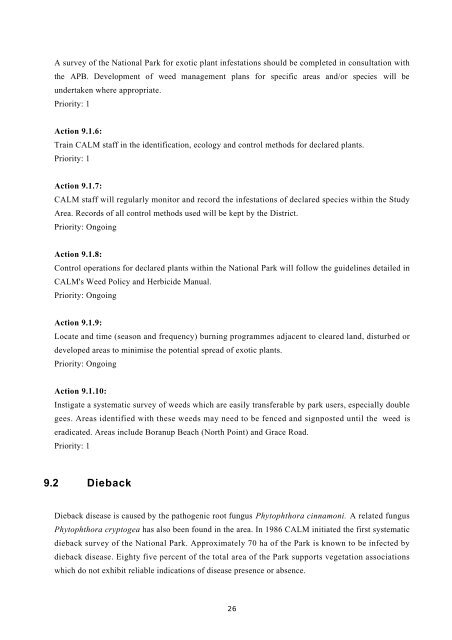leeuwin naturaliste national park management plan - Department of ...
leeuwin naturaliste national park management plan - Department of ...
leeuwin naturaliste national park management plan - Department of ...
- No tags were found...
You also want an ePaper? Increase the reach of your titles
YUMPU automatically turns print PDFs into web optimized ePapers that Google loves.
A survey <strong>of</strong> the National Park for exotic <strong>plan</strong>t infestations should be completed in consultation withthe APB. Development <strong>of</strong> weed <strong>management</strong> <strong>plan</strong>s for specific areas and/or species will beundertaken where appropriate.Priority: 1Action 9.1.6:Train CALM staff in the identification, ecology and control methods for declared <strong>plan</strong>ts.Priority: 1Action 9.1.7:CALM staff will regularly monitor and record the infestations <strong>of</strong> declared species within the StudyArea. Records <strong>of</strong> all control methods used will be kept by the District.Priority: OngoingAction 9.1.8:Control operations for declared <strong>plan</strong>ts within the National Park will follow the guidelines detailed inCALM's Weed Policy and Herbicide Manual.Priority: OngoingAction 9.1.9:Locate and time (season and frequency) burning programmes adjacent to cleared land, disturbed ordeveloped areas to minimise the potential spread <strong>of</strong> exotic <strong>plan</strong>ts.Priority: OngoingAction 9.1.10:Instigate a systematic survey <strong>of</strong> weeds which are easily transferable by <strong>park</strong> users, especially doublegees. Areas identified with these weeds may need to be fenced and signposted until the weed iseradicated. Areas include Boranup Beach (North Point) and Grace Road.Priority: 19.2 DiebackDieback disease is caused by the pathogenic root fungus Phytophthora cinnamoni. A related fungusPhytophthora cryptogea has also been found in the area. In 1986 CALM initiated the first systematicdieback survey <strong>of</strong> the National Park. Approximately 70 ha <strong>of</strong> the Park is known to be infected bydieback disease. Eighty five percent <strong>of</strong> the total area <strong>of</strong> the Park supports vegetation associationswhich do not exhibit reliable indications <strong>of</strong> disease presence or absence.26
















